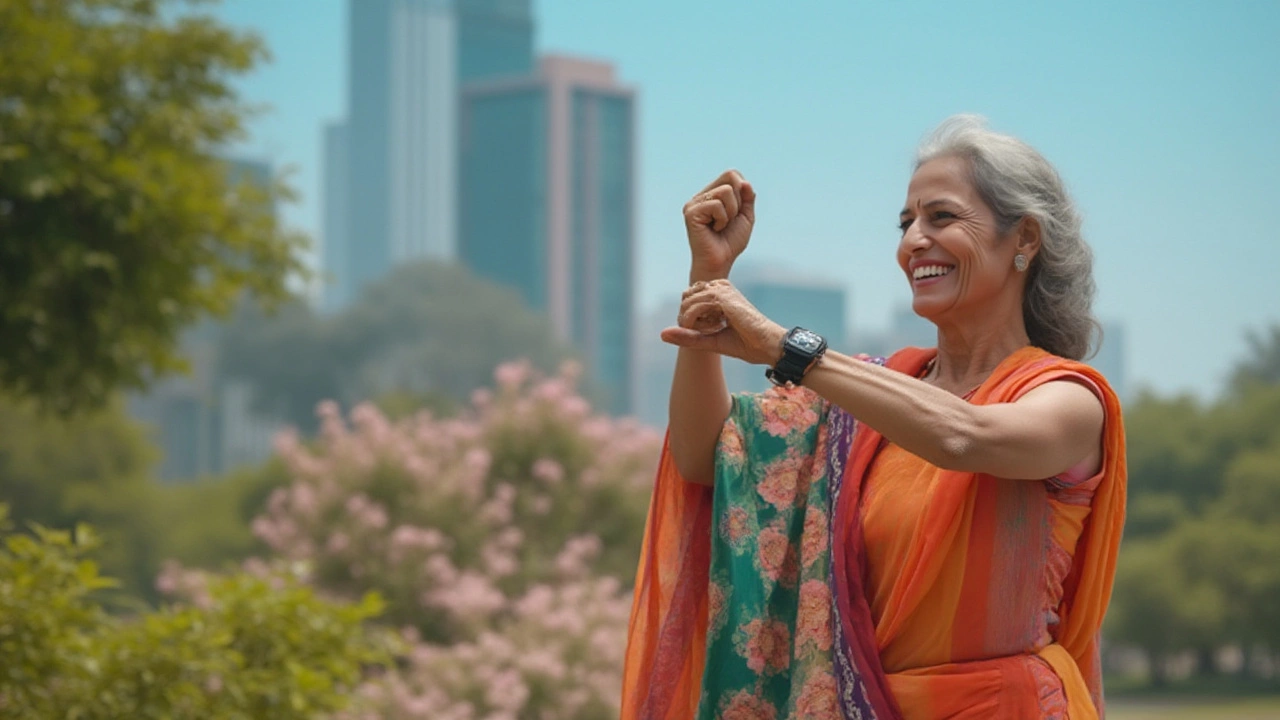Best Free Exercise Apps for Seniors: Top Choices for 2025
 Jul, 7 2025
Jul, 7 2025
If you searched for great free exercise apps for seniors, you probably found a sea of options promising the world—‘Easy movement!’ ‘Lose weight fast!’ ‘Pain-free joints!’ Most of them sound too good to be true. Tech's supposed to make things simple, but let’s be honest, sometimes it just leaves us staring blankly at screens, tapping random buttons, or giving up…for today, at least. But as more people over 60 pick up smartphones and try digital health solutions, a bunch of apps are proving they can be a helping hand (not just another headache) for older adults hoping to get moving, stay safe, and maybe actually have fun doing it.
Why Seniors Need Dedicated Exercise Apps
Fitness trends often target younger folks who can bounce through burpees like rubber bands—high-intensity, high-impact, high everything. But older bodies? They deserve something different. Most people over 65 deal with limited flexibility, balance concerns, joint issues (hello, knees!), or heart conditions. In fact, the CDC reports that over 80% of adults 65+ have at least one chronic health condition. That means the best exercise app for seniors should do way more than just count steps or show ab workouts. It should help build strength gently, support mobility, and improve balance—without feeling overwhelming or risky.
Dedicated senior apps focus on simple movements, bigger buttons, and clear instructions instead of millennial muscle-building jargon. They might include reminders to check posture, slow down, and never push through pain. And they often show real people (sometimes with grey hair!) demonstrating moves, not twenty-year-olds in neon crop tops. Plus, good apps track progress in a way that feels motivating, not discouraging. It’s about helping you feel confident—not like the odd one out.
There’s another reason older adults can benefit from the right app: social and mental wellness. The National Institute on Aging highlights how regular movement can fight loneliness and mild depression, boost independence, and even sharpen memory. Good apps add touches like gentle encouragements, community challenges, or guided breathing to tackle the whole wellbeing picture. The right app can be more than just a workout; it’s a spark for daily energy, mood, and routine.
What Makes an Exercise App Ideal for Seniors?
Hundreds of free exercise apps pop up every year. Sadly, most work for tech-savvy gym rats, not grandparents wanting to stretch while watching the weather. The best exercise app for seniors stands out because it is built for bodies—and minds—that need a gentle nudge, not a drill sergeant. Here are the must-have features experts and users agree on (after a lot of trial and error):
- Simple Navigation: No tiny menus or endless scrolling. Look for apps that offer big text, easy icons, and clear categories like "Beginner Workouts" or "Joint-Friendly Moves."
- Low-Impact Routines: Exercises should be knee-friendly and avoid sudden jerks or jumps. Think yoga, tai chi, Pilates, seated stretches, or gentle cardio—moves that build strength and balance without putting joints at risk.
- Modifications & Instructions: Top apps show alternative moves for all abilities. Instead of just saying “squat lower,” a good app might show you how to use a chair for support, or give you tips if you use a cane or have arthritis.
- Audio & Video Guidance: Photos aren’t enough. Seeing and hearing instructions in plain English (and sometimes other languages!) is vital. Bonus if the instructor speaks calmly and doesn’t rush the pace.
- Progress Tracking: Staying motivated can be tough, so tracking streaks, effort, and achievements in a friendly, non-judgmental way really helps.
- Reminders & Custom Notifications: Gentle push notifications that actually motivate (not annoy) are helpful for building consistency.
- Accessibility: Closed captions, adjustable font sizes, and high-contrast screens make a world of difference for vision or hearing challenges.
- Free or Low-Cost: Some apps tease “free” and then lock the good stuff behind paywalls. The most inclusive apps offer full-featured routines without needing a credit card.
Apps that tick these boxes stand the test of time, landing not just on “best of” lists, but on actual phones and tablets owned by real seniors—and that’s what counts the most.

The Top Free Exercise App for Seniors in 2025
The title of the exercise app for seniors most often recommended in late 2024 and 2025 belongs to “SilverSneakers GO.” Why does it get top marks from physical therapists, older adults, and caregivers?
SilverSneakers GO was built specifically for people 65 and up. You don’t need a club membership or health insurance plan to use the app (though insurance sometimes offers fun extras). The free version includes dozens of at-home routines, from short walking workouts to longer chair yoga sessions. Everything is built around mobility, flexibility, balance, and strength—in other words, what matters most for healthy aging.
Here’s what sets SilverSneakers GO apart:
- Easy setup, with tutorials for people who barely touch technology. Even if you haven’t used an app before, you can get started without stress.
- Routines ranging from 5 to 45 minutes, adaptable for different fitness levels. There’s never pressure to go longer or harder—just clear choices.
- Warm, friendly instructors (often seniors themselves) guide you step-by-step. No shouting, no intimidation, no lightning-speed transitions.
- Both video and audio guides, plus written step descriptions for each move. There are modifications for all levels, and clear safety cues like, "If this doesn’t feel right, just pause."
- Progress tracking with gentle milestones (like “Streak Week” for seven days in a row), but no intense competition or charts that make you feel behind.
- Class finder for in-person sessions at community centers (for users with full SilverSneakers access via insurance)—but home users still get the core routines anytime, anywhere.
- Customizable reminders that nudge you cheerfully—never nagging—with messages like, "Ready for your stretch?"
- Accessibility features: adjustable text size, high-contrast display, and spoken instructions for visual impairment.
One interesting fact: A 2023 study in the Journal of Geriatric Physical Therapy found that older adults using SilverSneakers routines three times a week saw a 22% improvement in balance scores after three months. That’s huge for preventing falls—the biggest cause of injury among seniors.
SilverSneakers GO isn’t the only app out there, but its dedication to comfort and inclusivity makes it a standout, especially if you're not training for a marathon but just want to move better and hurt less.
Other Excellent Free Exercise Apps for Older Adults
SilverSneakers GO takes the top spot, but everyone’s preferences differ. Maybe you love dance, prefer outdoors, or want a lighter style. Here are more standout free apps that work for many seniors in 2025, based on real user reviews and feedback from health professionals.
- Johnson & Johnson’s 7 Minute Workout: Don’t let the name fool you—there are routines for all ages and mobility levels. It’s super simple to set up, and you can pick sessions focused on flexibility or low-impact moves. The video instructors are calm and clear, without unnecessary hype. The best part? You can repeat or mix exercises based on your daily energy. If you only have 7 minutes, that counts!
- FitOn: While FitOn offers extra features for a fee, its free version includes lots of low-impact and chair-based workouts suitable for various abilities. The app feels young, but the “Senior Fitness” and “Gentle Stretch” sections are easy to find through the search bar. The pace is relaxed, and you can filter classes by length, difficulty, and type.
- Daily Yoga: For seniors interested in balance, flexibility, and stress relief, Daily Yoga has excellent guided routines. There’s a whole section labeled “Yoga for Seniors” with clear instruction, plus adjustable settings for flexibility and joint health.
- Go4Life from the National Institute on Aging: This browser-based platform (also accessible from most devices) isn’t exactly an app, but it offers senior-approved video routines, calendars, and printable guides for building strength, balance, and endurance. It’s free, science-based, and skips the sales pitches found in commercial apps.
- MyFitnessPal: If you’re interested in tracking food as well as activity, MyFitnessPal links with most basic step counters and wearables. Seniors who like numbers and logs will appreciate how easy it is to track progress, set reminders, and join “walking challenges.”
- Walk at Home by Leslie Sansone: For those who love gentle movement but can’t get outside every day, this free app mimics power walking indoors. Leslie’s encouraging voice and simple routines make it feel like moving with a good friend.
No matter which app you pick, make sure it offers at least the basics: clear instructions, moves you can do safely, some way to track your activity, and a friendly tone. Most apps let you try out routines before signing up or sharing personal info—don’t be afraid to experiment until you find one that “feels right.”

Tips for Getting the Most Out of Exercise Apps as a Senior
Picking the right app is step one, but making it work for you—every week, not just on “good” days—takes more than tapping a button. Here’s what real seniors and trainers suggest to keep the ball rolling:
- Start slow and steady: Even if you’re eager, don’t overdo it right away. Ten minutes daily beats a one-hour session once a month. Apps with short, adaptable routines let you build confidence at your pace.
- Set up your space: Whether you’re working out in your living room or backyard, clear enough area to move safely. Use a chair for support if balance wobbles; sneakers with proper support can make a world of difference too.
- Check with your doctor: Especially if you have heart issues, arthritis, or recent surgeries. Most doctors love seeing patients exercise but may have favorite routines or restrictions to suggest.
- Use reminders, not guilt trips: Allow the app to send gentle nudge notifications—but don’t treat them as “yelling.” If you skip a day, start again the next. Building a streak matters less than showing up often.
- Watch and listen carefully: Good apps demonstrate the right form, but pay attention to body signals too. If you feel pain or dizziness, pause. Modify or skip moves that feel wrong; your safety comes first.
- Recruit a friend: Doing app routines alongside a spouse, neighbor, or grandkid can make movement fun—and sticking with it easier. Some apps offer group challenges or video classes you can join together.
- Celebrate every win: Whether it’s a full routine or just standing from a chair with less effort, track progress in a journal, calendar, or the app itself. Seeing improvement keeps motivation higher.
- Explore variety: Rotate between stretching, strengthening, and balance exercises. Most top apps, like SilverSneakers GO, include a mix to avoid boredom and help different muscles.
- Keep tech simple: Update your app every few months to get new routines or bug fixes. If you get stuck, don’t sweat—ask a family member or library staff for quick help. You’re not alone.
Remember: exercise apps are tools, not coaches or doctors. Use them to discover new moves, make fitness a routine, and celebrate every bit of progress. There’s no perfect app for everyone—but finding one that fits your body and lifestyle can change how every day feels, at any age.
